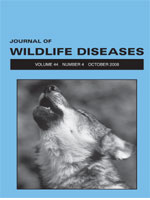We followed the course of canine parvovirus (CPV) antibody prevalence in a subpopulation of wolves (Canis lupus) in northeastern Minnesota from 1973, when antibodies were first detected, through 2004. Annual early pup survival was reduced by 70%, and wolf population change was related to CPV antibody prevalence. In the greater Minnesota population of 3,000 wolves, pup survival was reduced by 40–60%. This reduction limited the Minnesota wolf population rate of increase to about 4% per year compared with increases of 16–58% in other populations. Because it is young wolves that disperse, reduced pup survival may have caused reduced dispersal and reduced recolonization of new range in Minnesota.
How to translate text using browser tools
1 October 2008
DEMOGRAPHIC EFFECTS OF CANINE PARVOVIRUS ON A FREE-RANGING WOLF POPULATION OVER 30 YEARS
L. David Mech,
Sagar M. Goyal,
William J. Paul,
Wesley E. Newton

Journal of Wildlife Diseases
Vol. 44 • No. 4
October 2008
Vol. 44 • No. 4
October 2008
Canine parvovirus (CPV)
demography
dispersal
population
wolf




